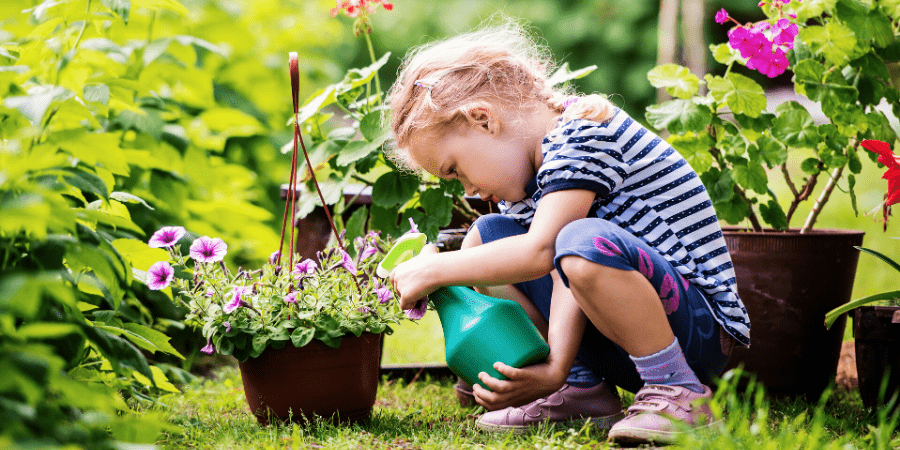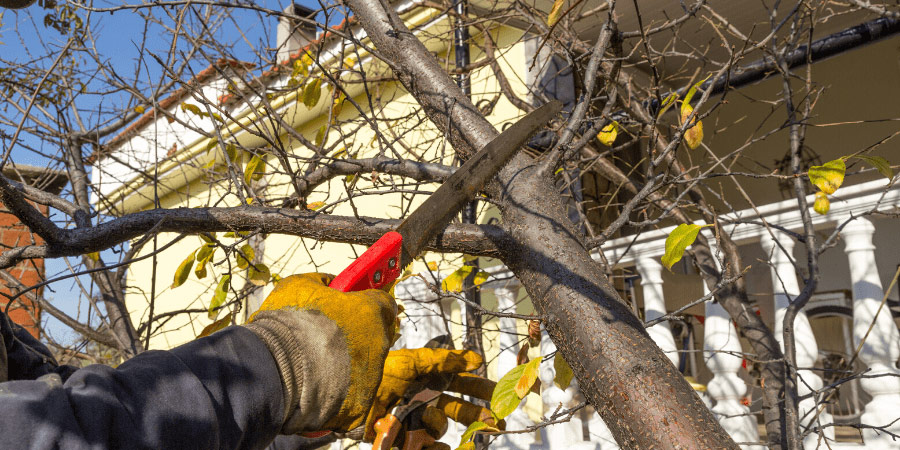Outdoor Activities For You and Your Kids
- Milorganite AgronomistMarch 26, 2020
We’re living through an unprecedented time in history; one I’m sure none of us ever thought we’d have to face. As the Coronavirus (COVID-19) spreads, we’re having to distance ourselves from each other, including our family, friends and communities that we would normally turn to for solace. One of the more reliable, comforting “friends” you can have, especially now, is your yard and garden.
The scope and range of our lives has contracted, but we can turn our focus to something that is therapeutic and productive: our yards and gardens. For many, working outside is anything but work. It’s quiet time for reflection. It’s being rejuvenated by the soil and sun. Gardening is a safe way to get out of the house, especially if you have kids.
Gardening has many positive psychological benefits. It has been shown to elevate our mood and reduce stress. A little time in the sun can go a long way too. Vitamin D is created in the skin when exposed to the sun, which is why it’s sometimes referred to as the “sunshine vitamin.” Vitamin D helps regulate our mood and promotes health and wellbeing.
Gardening is also good exercise, which can help improve our mood and lower anxiety, especially if you can’t go to the gym.
Everybody’s situation is different. Please follow all CDC state and local guidelines for appropriate activities for your area and your current health status.
Kid-friendly Gardening Activities
If you’re looking for kid-friendly activities, especially if they’re educational, here are some fun garden-related suggestions. If you can’t get out in the garden just yet, these are activities you can do indoors in preparation for planting outdoors.

Plan the Garden With Your Kids
Include your kids when planning this year’s garden and what to plant. You can talk about what plants need full sun and which do better in shady areas or explain the difference between annuals and perennials.
The Old Farmer’s Almanac has a helpful Planting Calendar tool so you know, specific to your area, what vegetables to plant and when. It provides a calendar for when to start seeds indoors, when to transplant, as well as when to sow seeds directly into the garden.
You can also contact your local extension office for a list of what will grow well in your area at this time of year.
Maybe it’s time for your kids to have a small garden of their own. Decide where in the yard or within an existing garden bed to mark-off as their own. Have them draw plans for their garden and shop for seeds online.
Start the Garden Indoors
If it’s too early to get into the garden, you may find Melinda Myers post helpful, which provides information on starting plants from seeds indoors. When selecting seeds to grow, make sure to read the seed packet or description for planting directions.
Myers recommends feeding the sprouting plants using a dilute solution of flowering houseplant fertilizer every two weeks. When it’s time to transplant the seedlings to the garden, mix Milorganite into the soil at the recommended rate.
Plant a Pizza in Your Garden
Consider a theme for the garden. It could be anything from plants that attract butterflies or all purple flowers, to a pizza garden in which you grow ingredients you’d find on a pizza. Consider having pizza to start the project and talk about the ingredients you can grow at home. A circular patch divided into “slices” might be fun. Celebrate the harvest by making a pizza made with the home-grown produce.
Kitchen Garden from Seeds and Scrapes
KidsGardening.org offers several kid-friendly indoor and outdoor gardening activities. One suggestion is to grow plants from items you already have in the kitchen. You can sprout and grow dried beans, lentils, mustard seeds and poppy seeds. You can also grow plants from kitchen “scraps,” such as avocado pits, citrus seeds, sweet potatoes, ginger root and root-vegetable tops, such as carrots. Green onions, or scallions, can be placed in a glass or jar with its roots in water and left on the counter. The greens and roots will continue to grow. You’ll get a few harvests you and your kids can use in cooking.
Create Seed Balls for the Garden
Another fun activity suggested by KidsGardening.org is to make seed balls. All you need is clay, potting soil and seeds, all available online. The seed balls can be planted in the garden when the weather warms up. You might consider sprinkling a little Milorganite into the mix. It’s non-toxic, so it’s kid-safe. The nutrients will release slowly and won’t harm tender seedlings.
Force Spring
Consider forcing bulbs, such as hyacinths, narcissus and amaryllis, for an indoor spring garden. After the bulbs are finished blooming, you and your kids can plant them in the garden for next season. Add a sprinkle of Milorganite as recommended. Kits are readily available online.
Paint Plant Pots
Kids can decorate terracotta pots for the garden. KidsGardening.org recommends using emulsion paint, which is water-based and easier to clean up.
Early-spring Gardening Tips for Adults
Here are several things you can do in the garden immediately, whether you’re in the North, South or transition zone. We also included a few ideas to keep kids occupied with educational, indoor/outdoor, garden-focused activities.
North
In the North, you can start working in the yard and garden in early spring once the soil has dried out, otherwise the foot traffic and heavy equipment can compact soil and damage grass shoots.
Clear the Yard
Remove any debris that may have collected on your lawn over winter. And while you’re out there, it’s a good time to clean the gutters, too.
If there are areas where snow piled up and it’s the last stubborn patch to melt, use a shovel or rake to distribute the snow.
After all the snow melts and the lawn has had a chance to dry out, use a leaf rake to gently loosen the grass that’s been compacted by snow. This discourages mold and diseases. You can inspect the yard for any problem areas while raking, such as bare patches and pest damage.

Prune
Trees and shrubs benefit from an annual pruning, which is best done while they’re dormant. The only shrubs that should be pruned in spring are fall-blooming shrubs. If you prune spring-blooming shrubs now, such as hydrangea, forsythia and lilacs, you’d be cutting off the buds that are only weeks away from blooming. Spring is the time to prune shrubs that bloom in late summer or fall.
It’s NOT Time to Fertilize
Don’t be tempted to fertilize your lawn just yet. In the North, wait until mid-May to Memorial Day when daytime temperatures are consistently in the 60s for the season’s first application of Milorganite.
Trees and shrubs can be fertilized in late-April to early-May.
South
Those in the South have the advantage of being able to get out into their yards and gardens almost any time of year. Here are a few things you can do now.
Deal with Weeds
Summer is on its way and so are the annual weeds that accompany it. If your yard was overrun by weeds last year, now is the time to apply a pre-emergent herbicide to keep them in check throughout the summer. If you can tolerate a handful of weeds, skip the pre-emergent herbicide. Spot treat winter weeds while they’re still growing. Follow all manufacturer directions and community guidelines before using herbicides, pesticides and fertilizers.
Start Mowing
It’s time for a walk! If you’re in an area where lawns are already breaking dormancy and turning green, it’s time to get out the mower. Make sure your mower is set to the correct height for your variety of grass.
Water to 1” Weekly
It may also be time to start watering the lawn to supplement rain. Lawns need 1” of water per week. If you have the sprinkler on to make up for the rain, maybe the kids would enjoy it, too!
Fertilize
The weather is warming up and it may be time to fertilize lawns in your area. Look for daytime temperatures consistently in the 70s and you’ll know it’s time. Using slow-release Milorganite will ensure your lawn gets a steady supply of nutrients for the next several months. Milorganite doesn’t contain pesticides or herbicides and, when used as directed, it’s non-toxic and safe to use in yards where kids and pets play. You’ll be able to quickly get out into your yard with confidence.
If you’d rather not go out to shop for Milorganite, check online to see if your local big box or hardware store offers in-store pick-up or home delivery.
Working in the yard and garden is a productive, healthy activity the entire family can enjoy, especially if your normal activities have been curtailed. Tending to the yard and garden has immediate benefits for your yard and garden, as well as for you and your kids. Together, you can tend to the garden and anticipate a plentiful harvest later in the year.
Again, please follow all CDC, state and local guidelines to ensure your safety, as well as that of others.
Be safe. Wash your hands.

